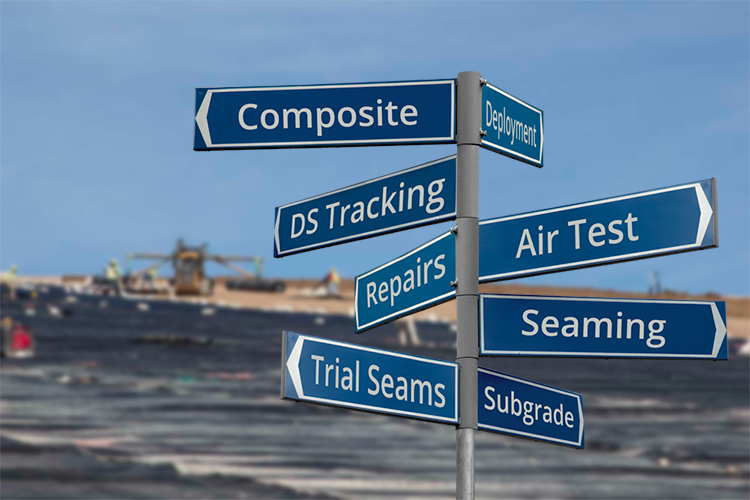
The clever fox outsmarts the hound in perhaps the most original version of this popular saying.
And much like the hound, a CQA technician on a geosynthetics installation can end up asking that same question. I know from experience—I’ve been the only technician on geosynthetics installations and there comes a time in nearly every day when you look at everything going on around you and feel overwhelmed. How do you, as a lone technician, keep up with a liner crew hell-bent on finishing a 10-acre project in two days?
Your day started off great, as things began at a slow pace. You walked the subgrade and all looks good. You even completed observation of trial welds, prior to deployment beginning—you feel like you are on top of the world! Hang on to that feeling, because things are about to change and before long you’ll be running around like a chicken with its head cut-off! The roller-coaster ride is about to begin!
As deployment begins, you anxiously wait for the first panel to get down so you can get started on the CQA end of things, like walking the panel, putting out any measurement grids, and getting your documentation started. The installer can’t get the panel down soon enough for you! Before long, the wedges slip into the seam—that sweet smell of molten plastic awakening your senses like fresh coffee on a cold morning. As you document the start times and locations of the first seams, you know you’ve got this! The chase begins and you’re hot on the tail of that fox.
Before long, the air pressure testing begins—hopefully not while the wedge is still in that segment of the seam! It’s about this time interruptions start to take away your focus, as well as ability to see everything going on. Perhaps it is the contractor talking to you about needing additional subgrade approved, which is several hundred feet away from where you are working. Perhaps the wedge operators decide they need to speed up the machine and run new trial welds. Meanwhile, the air test person is either moving like greased lightning, or taking 30 minutes per seam due to inexperience.
Oh, and did I mention the contractor is firing up an extrusion gun for repairs, meaning there are trial welds to observe! Right as you get ready to document one thing, someone is calling you to do something else. Maybe you see a panel blow-out and want to document and inspect it before it gets welded up; maybe you see something else going wrong, like a welding technician struggling with a wedge, subgrade getting damaged during deployment—whatever it may be, it slows your ability to not only observe everything going on, but also keep up on the documentation.
And, to top it off, the extrusion destruct failed, meaning you need to watch at least one more retest. Suddenly, the fox is getting a bit further away and your confidence in catching the fox takes a slight hit. However, you reason that you can catch everything up during your lunch hour—maybe the fox will be napping.
Foxes also seem to have luck on their side. As luck would have it, just as you grab your sandwich to eat while you catch up on the documentation, the earthwork contractor comes over and wants you to approve subgrade because the plan is now to “black-out” as much of the subgrade as possible due to the change in weather forecast. Figuring that will not take very long turns out to be a great underestimation—they have at best one panel of subgrade ready but the rest needs work due to their hurry. Of course, the liner crew takes a short lunch due to the changed forecast and begins deployment immediately.
Because the liner contractor is quality conscious, he/she wants to get destructs from the morning welding shipped out today. Your stomach churns—you realize you don’t have your documentation completed to even know how many destructs to mark. You don’t know if there are any suspect areas because you haven’t had a chance to walk the seams. Wisely, you realize you can buy some time by telling the contractor you prefer to take destructs only after non-destructive testing has been completed on the seams, as that makes perfect sense.
Then the contractor asks you how much of the area has been air tested, but you have no answer—therefore the contractor wants you to walk with them to figure it out. You assure the contractor you will mark them when you get time—but the contractor wants them marked now so the extrusion crew can patch the holes as they go, in order to get everything water-tight for the night. As the two of you walk the liner to figure out the extent of air testing, there are already a dozen intersection patches down, some of which appear to be covering up air pressure test information—or was the test really done in the first place?
Meanwhile, on the other end of the liner, panels continue to be deployed and it appears they have passed the area you said was approved. Wedges are in the seams, the air test crew is still hot on the heels of the welders, and the extrusion crew is making quick work of any damages which also means any destructs you mark on the liner will create new holes!
And, to top it off, it’s your lucky day—things somewhere are slowing down enough for the installation crew that they are going to fire up a vacuum box and concentrate on getting the tie-in done before rain causes sediment to cover the repairs! By this time, you may not even remember you were chasing the fox! The only thing you know is you are behind and you have an uphill battle to get everything done by the end of the day.
Hail the conqueror! You managed to mark destructs and have them shipped out, and stayed late to get all of the paperwork completed. (I realize some of this could be made easier by getting the paperwork from the installer and simply copying it, and perhaps that is the route you go—or even is the process your firm uses so you can keep up with things.)
Back at the motel, you check the paperwork; make a punchlist of only a couple outstanding items, and sit back to relax, knowing you are caught up. And then, perhaps as you are about to fall asleep, that thought hits you—did I really do CQA today, or was it all documentation? Did I miss anything? At that point, the fox got away!
I know the above illustration of activities may seem like an exaggeration to many, but it happens on a regular basis. I would like to pose a few questions to some of my reader base:
Technicians:
- How many of you have been in a position where you feel you were overwhelmed?
- What could be done to take some of the pressure off?
Owners
- Do you have requirements that an installer must give adequate notification to the QA firm prior to significant staffing changes?
- Do you have pre-approval requirements for new personnel coming to site for both installation and QA activities?
Engineers
- What procedures does your firm have in place to assure that CQA, not just documentation, is being performed?
- When the installer ramps up activities, how do you ensure quality is maintained?
Regulators
- How many of you have seen this happen in the field?
- What questions do you ask the technicians in the field to help get a handle on the quality of the project?
- Do you perform in field inspections of CQA/CQC personnel paperwork?



